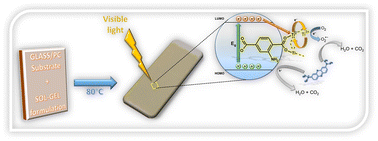Low temperature curable titanium-based sols for visible light photocatalytic coatings for glass and polymeric substrates†
Abstract
The sol–gel method provides a simple and versatile synthesis route to prepare photocatalytic coatings of benchmark catalyst titanium oxide (TiO2). However, photoactive TiO2 coatings require to be annealed at relatively high temperatures and this fact limits the type of substrate on which it can be used. In this study, hybrid transparent films based on the 2-aminobenzene-1,4-dicarboxylato (NH2BDC) ligand and titanium(IV) oxide were deposited on glass and polycarbonate substrates by immersing into a sol and annealing at 80 and 150 °C. Doped coatings exhibited a significant redshift of the band gap (2.37 eV) compared to that provided by neat TiO2 coatings (3.29–3.36 eV). The photocatalytic study of the films was carried out by assessing the photodegradation of a dye in aqueous solution. In this sense, when NH2BDC-sensitized coatings were illuminated with visible light, they surpassed the dye removal ability provided by neat TiO2 cured at 450 °C even when the latter was activated with UV light. Apart from this, while TiO2 coating performed best at low pH values (pH = 2–3), doped coatings exhibited their maximum performance at pH values of 4–6, closer to the freshwater pH range. The type of substrate and heat treatment influenced the final roughness of the film. Rougher films exhibited greater dye-adsorption capability, whereas denser coatings proved to be more effective in dye photodegradation. All doped coatings showed good adhesion with the substrates and medium hardness, despite the low annealing temperature.



 Please wait while we load your content...
Please wait while we load your content...